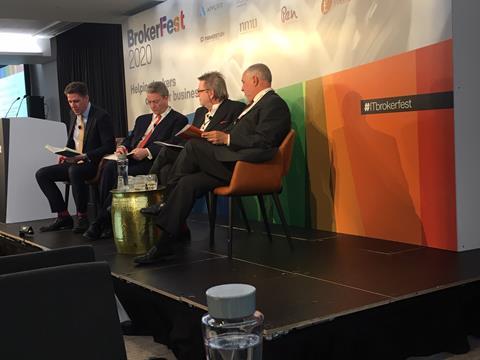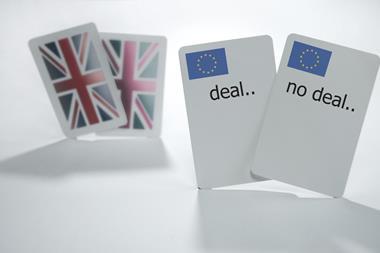Deals were up despite hardening markets
Deals peaked for Europe (including the UK) in mergers and acquisition (M&A) activity after many had been put on hold due to Brexit preparations in H1 2019.
Europe saw the biggest year-on-year increase with 155 deals (88 in H1 and 67 in H2), up from 122 in 2018.
And despite M&A activity dropping in the second half of the year, it remained resilient compared to the levels of recent years globally.
The UK formally left the European Union on 31 January this year delivering certainty in M&A where there was previous lull, a second wave of deals is now predicted.
This is according to a report released today from law firm Clyde & Co ‘Balancing risk and reward’.
Ivor Edwards, European head of Clyde & Co’s corporate insurance group, said: “A number of regional factors will impact M&A in 2020. Europe should see a return to business as usual now Brexit preparations are mainly completed but as the details of the future trading relationship between the UK and the EU remain unclear, this may spur transactions during the transition period.”
But he warned that “the length and the severity of the Coronavirus outbreak has the potential to deter potential investors and damage insurers’ balance sheets,” this could be the case in Asia Pacific (APAC), whereas the UK currently only has nine confirmed cases.
Hardening market
Clyde & Co expects M&A activity in the first half of 2020 to maintain the recent trend level at just under 200 deals worldwide.
Meanwhile the volume of mergers and acquisitions (M&A) in the insurance sector have increased 10% in 2019 with 419 deals globally – this was up from 382 in 2018.
The Americas continued to be the most active region (182 deals in 2019), but was slightly down from 189 in 2018. Activity was balanced between the first and second halves of the year (93 and 89 transactions respectively).
APAC followed with 69 deals – the largest number of these being in H1 2019. The Middle East and Africa saw rises throughout the year.
Key drivers for increased M&A were market remediation, technology and enhanced distribution.
Therefore, although the market is hardening it is not having a significant effect in balance sheets as this demonstrates that (re)insurance firms will continue to turn to M&A to deliver growth.
Edwards added: “M&A has surged in the last 12 months. While insurers have had some reasons for cheer in the past year, with reduced natural catastrophe losses and price rises taking hold across a range of classes of business, investment returns are still flat.
“This makes deal making a trusted route to growth and a means of satisfying shareholders. Although deal makers in some markets may adopt a more cautious approach, the quick start to 2020 in certain markets suggests there’s more to come.”
Market remediation
Market remediation has led to more businesses being placed into run-off.
As capacity is released following ongoing reviews by (re)insurers of classes of lines they will continue to underwrite and withdraw, this capacity could be applied elsewhere Clyde & Co says.
Vikram Sidhu, Clyde & Co partner in New York, said: “Activity in the run-off market is expected to pick up further in markets across the world.”
He gave the example of US insurers potentially taking further steps to explore divesting legacy books of insurance business through two recently enacted restructuring mechanisms – known as Insurance Business Transfers and corporate divisions.
“We expect these new tools for legacy business to lead to burst of new deal activity later this year and beyond,” Sidhu added.
Technology as key emerging driver
However, technology was seen as the most important emerging driver in 2019 in every region globally.
The last 12 months investments included US$250m from Munich Re into Next Insurance – a Californian start-up offering tailored, digital insurance solutions to small and medium-sized enterprises.
MS Amlin purchased an undisclosed stake in Envelop Risk – a Bermudian start-up that provides artificial intelligence-driven cyber risk modelling.
Joyce Chan, a Clyde & Co Partner in Hong Kong, said: “Technology is now a key consideration in any deal. Potential buyers are thinking how they can improve existing processes as well as develop new ones.
“They will be looking at targets which can deliver technological benefits at the back end – in terms of greater efficiencies – and enhance their customer reach and offering in the market.
“With many insurtech start-ups now reaching the point of maturity where their business models are proven, we expect a new wave of investment from carriers through acquisition, joint venture or partnership in the coming year.”
Mega deals
Finally, mega-deals valued in excess of $1bn continued to be a feature of the market with 20 transactions of this size in 2019, spread across all regions.
Enhanced distribution capability was a key driver of some of the biggest such as Prudential’s US$3.5bn acquisition of Assurance IQ, a direct-to-consumer platform.
Dusseldorf-based Clyde & Co counsel Kathrin Feldmann said: “The advantages of the ‘bigger is better’ philosophy remain hard to dispute.
M&A can deliver increased scale and reach, access to new customers and markets, and a wider pool of customer data, which is an increasingly valuable commodity.
“M&A at the top end of the market will continue but may be harder to get over the line due to a shrinking pool of targets and challenges in reaching agreement on price.
”Meanwhile, many re/insurers are starting to take a more considered view of M&A, aiming for smaller, more selected targets that add discrete value to their operations.”













































No comments yet